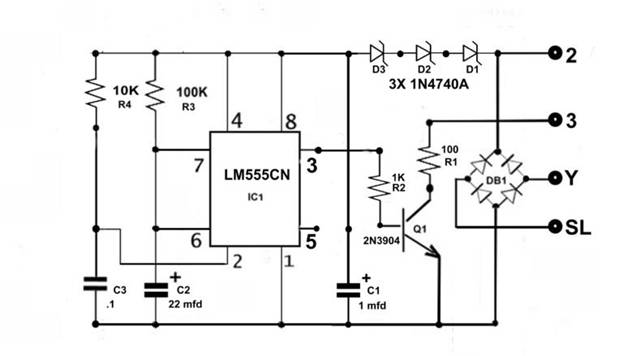
Watch-Dog For Telephones

Most telephone security devices available in the market are simple yet quite expensive. These devices typically provide blinking or beeping indications of line-tapping or misuse but often do not guarantee protection against unauthorized operations. A unique and straightforward circuit for a telephone watchdog that safeguards subscriber telephone lines against fraud is described here. This circuit continuously monitors the telephone lines and sounds an alarm in case of any misuse. Additionally, it transmits a loud tone through the telephone lines to deter further misuse. When switch S1 is turned on, the normal (on-hook) telephone line voltage at the output of bridge rectifier diodes D1 to D4 is approximately 48 volts, which exceeds the breakdown voltage of zener diode D5, causing it to conduct. Consequently, transistor T2 becomes forward-biased, effectively grounding the base of transistor T1, which is then cut off, preventing power supply to the rest of the circuit. In this state, the circuit consumes only a negligible current, which does not affect the telephone line condition. However, when the handset of any telephone connected to the lines is lifted (off-hook), the line voltage drops to about 10 volts. This causes transistor T2 to switch off, allowing transistor T1 to become forward-biased through resistor R1. The astable multivibrator, built around timer IC1, then starts oscillating, activating the speaker to sound an alarm. The output of the astable multivibrator is also connected to the base of transistor T1 through capacitor C5, resulting in a loud and irritating tone being heard in the earpiece of the unauthorized telephone instrument. This circuit can be easily constructed on a veroboard using low-cost components and can be connected to any telephone line without the risk of malfunction. No additional power supply is required, as it draws power from the telephone line for operation.
The described telephone watchdog circuit consists of several key components that work together to provide continuous monitoring and alerting functionality. The bridge rectifier, composed of diodes D1 to D4, converts the alternating current (AC) from the telephone line into direct current (DC), providing a stable voltage for the circuit's operation. The zener diode D5 is crucial for voltage regulation, ensuring that the voltage does not exceed safe levels for the components involved.
Transistor T2 acts as a control switch, responding to the line voltage conditions. When the telephone is on-hook, the high voltage keeps T2 conducting, which in turn prevents T1 from turning on. This design ensures that the circuit remains inactive and does not interfere with normal telephone operations. The transition to the off-hook state is what triggers the alarm system. The astable multivibrator, formed by timer IC1, generates a square wave signal, which drives the speaker to produce a loud tone. The use of resistor R1 and capacitor C5 ensures that T1 is activated only under the right conditions, providing a robust response to unauthorized access.
This circuit's simplicity and reliance on readily available components make it an attractive option for users seeking to enhance the security of their telephone lines without incurring high costs. Its design allows for easy integration into existing telephone systems, and its low power consumption means it will not disrupt normal service. Overall, this telephone watchdog circuit serves as an effective deterrent against unauthorized use, ensuring the integrity of telephone communications.Most of the telephone security devices available in market are simple but quite expensive. These devices provide blinking or beeping type line-tap/misuse indications. Quite often they do not offer guaranteed protection against unauthorized operation. A very simple and unique circuit of a telephone watch-dog to safeguard subscriber telephone lines against any fraud is described here. This little circuit keeps continuous watch over the telephone lines and sounds an alarm in case of any misuse. In addition it transmits a loud tone through the telephone lines to prevent further misuse. When switch S1 is turned on, the normal (on-hook) telephone line voltage at the output of bridge-rectifier diodes D1 to D4 is approximately 48 volts, which being well above the break-down voltage of zener diode D5, the diode conducts.
As a result transistor T2 gets forward biased. This effectively grounds the base of transistor T1 which is thus cut off and the remaining circuit does not get any power supply. In this state, only a small (negligible) current is taken by the circuit, which will not affect the telephone line condition.
However, when handset of any telephone connected to the telephone lines is lifted (off-hook), line voltage suddenly drops to about 10 volts. As a result, transistor T2 is switched off and transistor T1 gets forward biased via resistor R1. Now, the astable multivibrator built around timer IC1 starts oscillating and the speaker starts sounding.
Output of the astable multivibrator is also connected to the base of transistor T1 through capacitor C5. As a result, only a loud (and irritating) tone is heard in the ear-piece of the unauthorized telephone instrument.
This circuit can be constructed on a veroboard using easily available low-cost components and it can be connected to any telephone line without the fear of malfunctioning. No extra power supply is required as it draws power from the telephone line for operation. 🔗 External reference
The described telephone watchdog circuit consists of several key components that work together to provide continuous monitoring and alerting functionality. The bridge rectifier, composed of diodes D1 to D4, converts the alternating current (AC) from the telephone line into direct current (DC), providing a stable voltage for the circuit's operation. The zener diode D5 is crucial for voltage regulation, ensuring that the voltage does not exceed safe levels for the components involved.
Transistor T2 acts as a control switch, responding to the line voltage conditions. When the telephone is on-hook, the high voltage keeps T2 conducting, which in turn prevents T1 from turning on. This design ensures that the circuit remains inactive and does not interfere with normal telephone operations. The transition to the off-hook state is what triggers the alarm system. The astable multivibrator, formed by timer IC1, generates a square wave signal, which drives the speaker to produce a loud tone. The use of resistor R1 and capacitor C5 ensures that T1 is activated only under the right conditions, providing a robust response to unauthorized access.
This circuit's simplicity and reliance on readily available components make it an attractive option for users seeking to enhance the security of their telephone lines without incurring high costs. Its design allows for easy integration into existing telephone systems, and its low power consumption means it will not disrupt normal service. Overall, this telephone watchdog circuit serves as an effective deterrent against unauthorized use, ensuring the integrity of telephone communications.Most of the telephone security devices available in market are simple but quite expensive. These devices provide blinking or beeping type line-tap/misuse indications. Quite often they do not offer guaranteed protection against unauthorized operation. A very simple and unique circuit of a telephone watch-dog to safeguard subscriber telephone lines against any fraud is described here. This little circuit keeps continuous watch over the telephone lines and sounds an alarm in case of any misuse. In addition it transmits a loud tone through the telephone lines to prevent further misuse. When switch S1 is turned on, the normal (on-hook) telephone line voltage at the output of bridge-rectifier diodes D1 to D4 is approximately 48 volts, which being well above the break-down voltage of zener diode D5, the diode conducts.
As a result transistor T2 gets forward biased. This effectively grounds the base of transistor T1 which is thus cut off and the remaining circuit does not get any power supply. In this state, only a small (negligible) current is taken by the circuit, which will not affect the telephone line condition.
However, when handset of any telephone connected to the telephone lines is lifted (off-hook), line voltage suddenly drops to about 10 volts. As a result, transistor T2 is switched off and transistor T1 gets forward biased via resistor R1. Now, the astable multivibrator built around timer IC1 starts oscillating and the speaker starts sounding.
Output of the astable multivibrator is also connected to the base of transistor T1 through capacitor C5. As a result, only a loud (and irritating) tone is heard in the ear-piece of the unauthorized telephone instrument.
This circuit can be constructed on a veroboard using easily available low-cost components and it can be connected to any telephone line without the fear of malfunctioning. No extra power supply is required as it draws power from the telephone line for operation. 🔗 External reference


